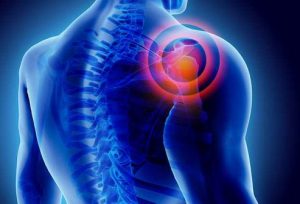 Alecia Dayger is a massage therapist and yoga instructor at Om Namo Center. This month, she sheds light on a common and sometimes confusing shoulder ailment.
Alecia Dayger is a massage therapist and yoga instructor at Om Namo Center. This month, she sheds light on a common and sometimes confusing shoulder ailment.
You may have first noticed it three or four weeks ago, while reaching for a glass in the kitchen. It was never unbearable, but the physical discomfort and movement limitations have seemed to worsen over time. If you’re experiencing pain and a gradual, increased loss of mobility in your shoulder, it is possible that you have “frozen shoulder.”
What is it?
Frozen Shoulder Syndrome is a condition that presents with symptoms of pain, stiffness and limited mobility in the shoulder joint. Frozen shoulder is thought to happen when scar tissue forms in the shoulder. This causes the joint capsule of the shoulder to thicken and tighten, leaving less room for movement. Movement may become stiff and painful, and range of motion gradually decreases. It is most prevalent in the age range of 40 to 60 and is more common in people assigned female at birth. Frozen shoulder syndrome typically presents in one of two ways:
- Following an injury, medical condition, or medical procedure that has immobilized the shoulder joint.
- A spontaneous onset of pain with progressive shoulder movement restrictions of unknown cause. This is referred to as idiopathic onset.
Frozen shoulder syndrome is also called adhesive capsulitis because of the associated thickening, shortening, and hardening of the connective tissue capsule that surrounds the joint. However, in cases of idiopathic onset, protective guarding of the shoulder muscles, and not joint capsule contracture, presents as a major contributing factor to movement restrictions (Ginn et al, 2018).
Frozen shoulder syndrome is marked by three stages: freezing, frozen, and thawing.

What can I do about it?
Interventions for frozen shoulder are dependent on the stage of the syndrome, and range from conservative to invasive. The first stage, lasting 6 weeks to 6 months, is often referred to as freezing. Treatment during the freezing stage focuses on pain relief and may include the application of heat and ice, or a doctor prescribed injection of anti-inflammatory and pain relieving medication.
Stage two, or frozen, can last 4 to 6 months. Interventions during the frozen stage aim to maintain mobility and strength, with the goal of improving long term functional outcomes. Conservative treatment may include massage therapy, range of motion exercises, and isometric strengthening. If these modalities fail to curb symptom progression and provide some relief, the treatment of a frozen shoulder may lead to the operating room for manipulation under anesthesia or arthroscopic release and repair.
The final stage of frozen shoulder syndrome is called thawing and can last 6 months to 2 years. While in the thawing stage, treatment techniques are geared toward regaining range of motion and strength that was lost over the course of the syndrome. Interventions may include progressive massage therapy techniques, stretching and strengthening exercises, and return to work or sport protocols that focus on task-specific movements.
Treatment Outcomes
The average course of natural resolution is 30 months, so any improvement on that timeline is deemed a success. While recovering from a frozen shoulder can be a long and arduous process, massage therapy serves as a noninvasive approach to support physical recovery and provide relief from mental and emotional strain. At each stage of frozen shoulder syndrome, specific massage techniques can be used to support the goal of relieving pain, maintaining mobility and strength, or regaining range of motion and strength. In cases of spontaneous onset, massage therapy is one of the best modalities for retraining the nervous system and reducing the protective muscle guarding that produces movement restrictions. Furthermore, massage therapy has positive effects on biochemistry, including lowering levels of the stress hormone cortisol and increasing levels of the mood-stabilizing neurotransmitters serotonin and dopamine (Field et al, 2005). Treating a frozen shoulder with massage therapy can support clients in managing the physical, mental, and emotional challenges during the rehabilitation process.
If you have been diagnosed with Frozen Shoulder Syndrome, please reach out to our staff at Om Namo Center to learn how we can support you on your path to recovery.
To learn more about treatments with Alecia, or massage therapy at Om Namo Center, click here.
References:
Hollman, L., Halak, M., Kamper, S.J., Haber, M., Ginn, K.A. Does muscle guarding play a role in range of motion loss in patients with frozen shoulder? Musculoskeletal Science and Practice 2018;37:64-68
Field, T., Hernandez-Reif, M., Diego, M., Schanberg, S., Kuhn, C. Cortisol decreases and serotonin and dopamine increase following massage therapy. International Journal of Neuroscience 2005; 115(10):1397-413



